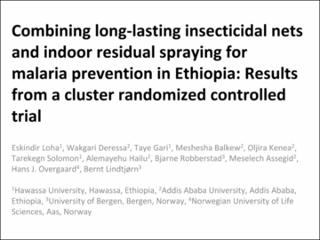Combining long-lasting insecticidal nets and indoor residual spraying for malaria prevention in Ethiopia: a cluster randomized controlled trial
Loha, Eskindir; Deressa, Wakgari; Gari, Taye; Balkew, Meshesha; Kenea, Oljira; Solomon, Tarekegn; Hailu, Alemayehu; Robberstad, Bjarne; Assegid, Meselech; Overgaard, Hans J.; Lindtjørn, Bernt
Conference object
Permanent lenke
https://hdl.handle.net/11250/2733239Utgivelsesdato
2017-11-01Metadata
Vis full innførselSamlinger
- Publications [1488]
Originalversjon
Presented at: American Society of Tropical Medicine and Hygiene 66th Annual Meeting. Baltimore, Maryland, USASammendrag
Background Long lasting insecticidal nets (LLINs) and indoor residual spraying (IRS) are effective tools to prevent malaria, but the effectiveness of combining the two are not yet fully understood. This study compared the separate versus combined effect of LLINs and IRS on malaria incidence and anemia. Methods This cluster randomized controlled trial was done in the Adami Tullu district in south-central Ethiopia for 119 weeks, from September 2014 to January 2017. Prior to the trial, we did a pilot study to estimate the sample size, and registered 8 malaria episodes per 10,000 person-weeks of observation (PWO). 6072 households (HHs) were randomly assigned to four intervention arms: LLINs + IRS, LLINs, IRS, and no intervention implemented by the project (control). The primary outcome was malaria incidence. Analysis was based on an intention-to-treat principle. Each arm had 44 clusters with an average of 35 HHs per cluster; the total population was 34,548. PermaNet 2.0 LLINs were distributed in September 2014, and IRS (with propoxur) was carried out yearly. Active and passive case detection were done weekly. Malaria was diagnosed using a rapid diagnostic test (CareStartTM). Anemia was assessed through yearly surveys on children. The yearly rainfall was 60% of expected in 2015 (El Nino effect), entomological studies were simultaneously conducted. Results The overall malaria incidence was 2.91 per 10,000 PWO (37% of pre-intervention incidence), and similar in the four arms with 2.99 (LLINs + IRS), 2.92 (LLINs), 3.01 (IRS) and 2.72 (control). Generalized estimation equation showed that LLINs did not provide individual protection. Entomological findings showed greater outdoor mosquito human-biting activities than indoor. The yearly mean hemoglobin concentrations were similar among the trial arms. Conclusions The malaria incidence was low and similar in the intervention arms. The severe drought might have contributed in too
